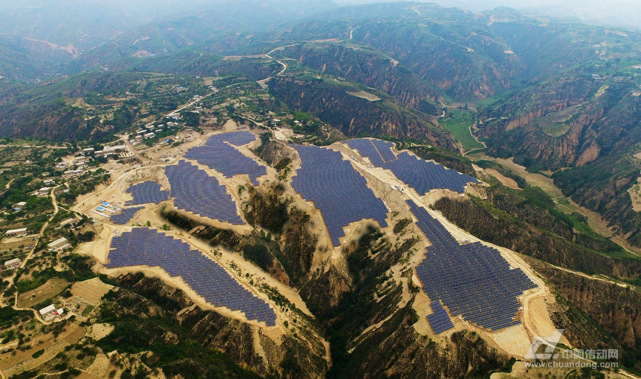According to a report issued by the UN Renewable Energy Agency, the cost of photovoltaic power generation has dropped by 70% in the past 7 years. With the advancement of technology, the world has witnessed explosive growth. Last year, China’s PV industry also ushered in the best opportunities for development in the past decade. The country’s newly installed capacity exceeded 50 GW for the first time and completed the “13th Five-Year Plan†ahead of schedule. The development situation is excellent. Imagining the future, the development trend of the photovoltaic industry and development bottlenecks have become the focus of attention in the industry. The picture above shows the project of Longji 15MW Photovoltaic Poverty Alleviation Power Station in Yanchuan County, Shaanxi Province 1000GW, 1 billion kilowatts. This is the installed capacity of the global PV power generation installed in the next 5-7 years in the China (Xi'an) Photovoltaic Hard Technology Innovation Summit held recently. Compared to the current scale of only 200 million kilowatts, 1 billion kilowatts means a nearly 5-fold increase. However, according to Li Junfeng, chairman of the China Energy Research Association Renewable Energy Professional Committee, this scale is still far from being large enough. Not only is it unable to meet global demand, it is even unable to meet China's development goals. Photovoltaic industry development momentum “Everyone can see that the photovoltaic industry is very interesting, because we are talking about the global market nominally, but in fact, the global market is mainly the Chinese market, or the Asian market. The installed capacity of photovoltaic power in Asian countries accounted for global in 2016. Half, the current figure is 2/3, of which 50% is in China. We can clearly see that the main force of solar energy development is China.†Michael Schemla, senior advisor to the European Photovoltaic Industry Association, said at the meeting. According to data from the Citi think tank, China’s polysilicon production was 238 thousand tons in 2017, a year-on-year increase of 22.6%, accounting for 59% of global production; wafer, cell, and module production were 85, 71, and 66GW, respectively. It accounts for 85%, 63% and 68% of the world's total production. There are more than 5 companies in all aspects of the industry chain, which ranks among the top ten in the world. From the perspective of the installed capacity of the power station, China's newly installed photovoltaic capacity reached 53 million kilowatts last year, ranking first in the world for five consecutive years. It also replaced thermal power for the first time in the country, becoming the largest installed power source in the year. As of the end of last year, China’s cumulative installed capacity exceeded 130 million kilowatts and completed the “13th Five-Year Plan†ahead of schedule. Geng Zheyi, deputy chief engineer of the State Grid Corporation Dispatching Control Center, disclosed more positive information at the meeting. According to him, distributed photovoltaics will also complete the "13th Five-Year Plan" ahead of schedule: "As of the end of December last year, China's distributed photovoltaic installed capacity was 19.44 million kilowatts, an increase of 3.7 times year-on-year. If growth continues at this rate, In 2019, the photovoltaic industry may complete the '13th Five-Year' plan of 60 million kilowatts of distributed targets." Zhe Zheyi also stated that “the 13th Five-Year Plan for Photovoltaic Power Generation will continue to develop rapidly, as will the international community. The development momentum of the photovoltaic industry is very strong.†Lower cost supports expansion of scale According to Li Zhengguo, president of Longji Green Energy Technology Co., Ltd., the rapid development of China's photovoltaic industry is due to the continuous reduction in the cost of the photovoltaic power generation industry. “This makes the competitiveness of photovoltaics for traditional energy sources continue to increase, so the development of the photovoltaic market has reached 100 million kilowatts in 2017 from the scale of the 100,000-kilowatt market in the beginning of this century.†According to Li Zhenguo, in recent years, the photovoltaic industry technology has continuously improved, the cost has been declining, and the efficiency has been continuously improved. In the past ten years, the cost of photovoltaic power generation systems has been reduced from US$10/W to US$1/Wat, with a 90% reduction. Among them, the monocrystalline silicon wafer market price per watt 10 years ago was 100 yuan, but has recently dropped to 4.55 yuan, less than 5% a decade ago. The cost of electricity is reduced from US$1/kWh to below US$0.1/kWh. In recent years, there have been several power plants below 33/kWh in the Middle East and South America. However, Guodian Investment Xie Xiaoping, chairman of the upper reaches of the Yellow River, pointed out that the main problem in the development of photovoltaics in China is the cost issue: “So far, the photovoltaic industry still needs subsidies, and the industries that need subsidies are actually not sustainable. Therefore, photovoltaics are Early access to affordable Internet access is the key to the healthy development of the industry." Li Zhenguo said that although China's photovoltaic industry is currently pursuing low-cost Internet access, photovoltaics have become the cheapest clean energy in the world. “The development of energy storage industry is not as fast as photovoltaic, but if we look forward to the next decade, the cost of energy storage is likely to fall. The current 1/3. Therefore, it is believed that the economical nature of 'photovoltaic + energy storage' will be realized within 10 years." Is 1 billion kilowatts enough? How large will the future PV market be? “The result of our speculation is that in the next 5-7 years, the global PV installation will reach 1,000 GW. This scale is equivalent to the capacity of all existing thermal power installations in China and half of the world's thermal power installations. Considering the 20-30 years of life of photovoltaic power plants. In the future, the photovoltaic market will add thousands of GW each year and become an industry that can continue to develop. The prospects are extremely large, said Li Zhenguo. MichaelSchemla also expects that the market will continue to grow in the next five years. "Only 1% of electricity in China comes from solar energy, and in many countries in Europe, this ratio is as high as 5%-6%. Therefore, there is still much room for improvement in China's PV." For Li Zhaoguo's 1000GW development goal, Li Junfeng made a straightforward assessment: “This scale is too conservative and far from enough.†He said that the National Development and Reform Commission and the National Energy Administration released the “Revolution Strategy of Energy Production and Consumption†last year (2016— 2030), where it is clear that non-fossil energy will account for 15% of the total by 2020, 20% by 2030, and more than 50% by 2050. “At present, the development of nuclear power has encountered unprecedented difficulties, and hydropower and wind power have been exhausted. No subversive changes are possible. All countries in the world are facing the same problem. Therefore, photovoltaics will have high hopes.†Li Junfeng calculated an account: China's preliminary idea to 2030 is that per capita consumption of 8,000 kWh, according to 1.4 billion people, will consume 10.2 trillion kWh per year. Last year, the photovoltaic power generation amounted to 110 billion kWh, equivalent to 1% of the national electricity generation. If the ratio of photovoltaic power generation reaches 10%, that is, 1.1 trillion kWh. According to the current efficiency, photovoltaic needs at least 800 million kilowatts to achieve this goal. Therefore, 1 billion kilowatts should not be the goal of the world. Even China's goal is not reached. If PV reaches about 1.5 trillion kWh by 2030, then it will need 1.2 billion kilowatts. “Therefore, from a scale perspective, photovoltaics will have a long way to go,†said Li Junfeng. “There are currently 12 years left until 2030. If we want to reach 800 million kilowatts of installed capacity, we will have at least 50 million kilowatts of new installed capacity each year. Therefore, we should not reduce the scale. But should increase moderately." In addition, Li Junfeng believes that PV has been at a slow decline in cost, and the space for technological breakthroughs in driving down costs has been very limited. The reason why a number of projects in foreign countries can realize a cost of 3 cents for electricity is not mainly due to technological advances in hardware, but benefits from "soft" policies. "So, 'hard' technologies have to be improved and 'soft' policies must keep up. As the industry continues to develop on a large scale, the 'soft' policy will become more and more obvious." Source: China Energy News Author: Gu Kehua
According to the working frequency response ranges, speakers can be classified into tweeters, mid ranges, woofers and full ranges.
FAQ
Q1. What is the MOQ?
Speakers By Frequency,High Bass Speakers,Small Loudspeakers,High Frequency Speaker Shenzhen Xuanda Electronics Co., Ltd. , https://www.xdecspeaker.com



XDEC: 2000pcs for one model.
Q2. What is the delivery lead time?
XDEC: 15 days for normal orders, 10 days for urgent orders.
Q3. What are the payment methods?
XDEC: T/T, PayPal, Western Union, Money Gram.
Q4. Can you offer samples for testing?
XDEC: Yes, we offer free samples.
Q5. How soon can you send samples?
XDEC: We can send samples in 3-5 days.